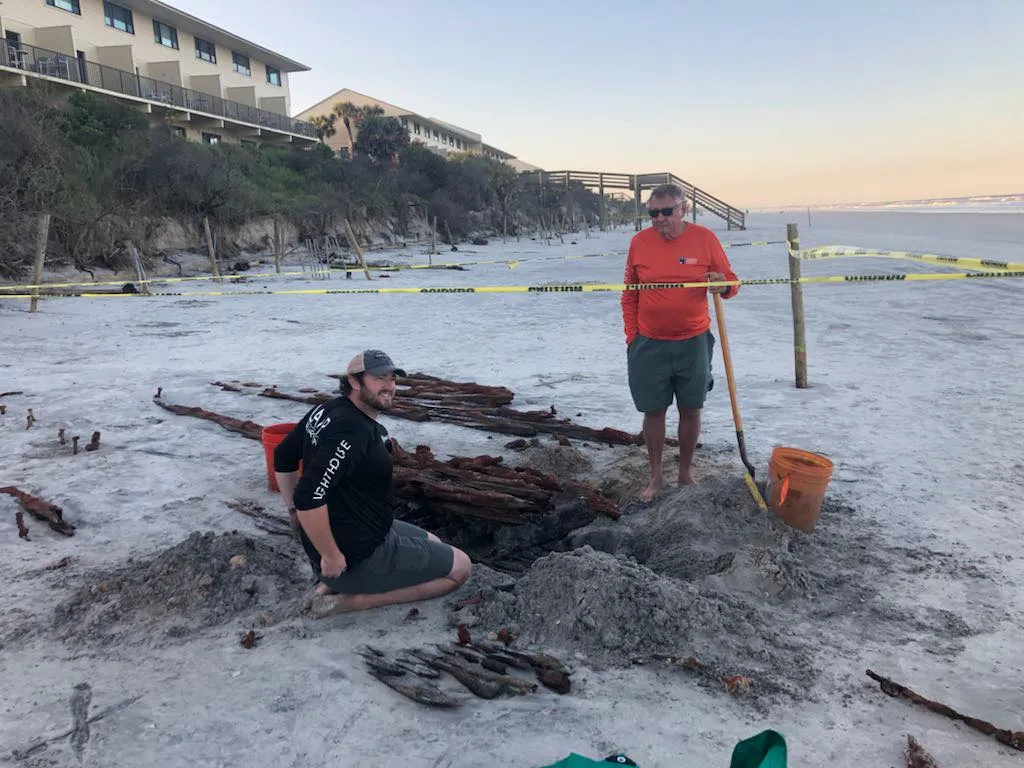Shipwreck Exposed by Erosion on Florida Coast Could Be 200 Years Old
Archaeologists think the vessel was likely a 19th-century merchant ship
:focal(740x541:741x542)/https://tf-cmsv2-smithsonianmag-media.s3.amazonaws.com/filer/8b/35/8b35e0c0-9cd1-431c-bc53-5cf2b4ca2ffa/shipwreck2.jpg)
Erosion on a Florida beach has revealed a shipwreck that archaeologists say may be as much as 200 years old.
As Jessica Clark reports for First Coast News, local Mark O’Donoghue was walking on Crescent Beach in St. John’s County on Saturday, as he does almost every day, when he saw “some timbers and metal spikes” sticking up through the sand.
O’Donoghue reached out to the St. Augustine Lighthouse Archaeological Maritime Program (LAMP), which sent researchers to investigate. After assessing the site, the team determined that they’d stumbled onto the wreckage of a vessel that likely ran aground on Florida’s northeast coast during the 19th century, when Crescent Beach looked decidedly different.
“The sand dune wasn’t here when the ship wrecked,” archaeologist Chuck Meide tells First Coast News. “We know topography and the landscape of a coast changes a lot."
He speculates that a storm eventually pushed the shipwreck far up on the beach, where sand formed around it.
Based on the wooden timbers and iron fasteners, Meide tells Ryan Nelson of Action News Jax that the vessel was most likely a merchant ship.
“It was probably a cargo ship, carrying goods, again in the 1800s,” he says. “Think of it kind of like a Walmart semi-truck: a ship that was carrying a bunch of, could be hardware, could be flour, could be all kinds of different commodities.”
Meide posits that whoever operated the ship spoke English, as various parts of the vessel were “cut in feet and inches.”
“[T]he keelson, for example, was 12 inches across,” he explains to Action News Jax. “So, that tells us that it is more likely to be an American ship, a Canadian ship or a British ship.”
As waves rolled onto the beach at high tide on Saturday, more sections of the ship became visible.
“A substantial part of the structure is still beneath what we can see,” Nick Budsberg, another LAMP archaeologist, tells Clark for a separate First Coast News report.

Budsberg outlines several possible scenarios that could have brought the ship to the spot where it sat for centuries.
“It might have been at the end of its life, and they ran it up on the beach and called it a day,” he says. “Or it is possible it wrecked further out to sea and a portion of the ship made it to the beach.”
The archaeologists also found burn marks on some of the ship’s timbers.
“My gut is telling me the burning happened after the ship wrecked,” Meide tells First Coast News. “Someone very well could have burned it for salvage purposes because then you shift through the ashes and pull out metal spikes and sell for scrap.”
Writing on the LAMP Facebook page, the researchers say they will continue to study the timbers, both onsite and in the lab, to seek more information about the wood’s age and origin.
Many beachgoers gathered to see the archaeologists studying the wreck.
“We saw all the activity and asked what’s going on,” observer Lisa Snyder tells First Coast News. “We got to talk to some of the archaeologists. It’s just fascinating.”
But the discovery also has a dark side: It reflects the growing problem of beach erosion, a natural phenomenon exacerbated by climate change. In a paper published earlier this year in Nature, scientists pointed out that almost half of Earth’s sandy beaches could vanish by the end of the century.
Pat Lee, who lives near the spot where the shipwreck was discovered, tells First Coast News that the ship only became visible due to the massive loss of beach sand in recent years.
“The wreckage there used to be under ten feet of sand,” he says. “In the last three years, we lost it. We lost it all. … It’s very cool to see the shipwreck. It is very disturbing to see the sand leave our beach.”
Still, O’Donoghue tells Action News Jax that he’s excited to be part of a historical find.
“It’s awesome!” he says. “The fact that we’re going to uncover it, or that LAMP [is] going to uncover it, and hopefully that it can be shared with future generations, it’s part of our history.”
Meide says moving and preserving the wreck would cost millions of dollars, so for now, at least, it will remain on the beach.
/https://tf-cmsv2-smithsonianmag-media.s3.amazonaws.com/accounts/headshot/Livia_lg_thumbnail.png)
/https://tf-cmsv2-smithsonianmag-media.s3.amazonaws.com/accounts/headshot/Livia_lg_thumbnail.png)